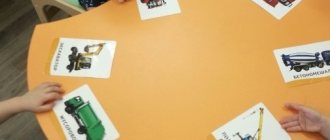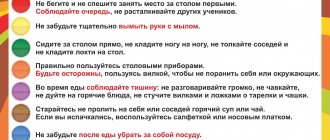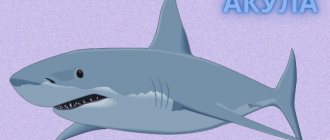Summary of the final lesson for children of the middle group on the topic: “Journey through the seasons”
Author: Belikova Vera Aleksandrovna, teacher of the MKDOU “Kalacheevsky kindergarten No. 1 of a general developmental type”
Explanatory note to the author's material
This lesson is intended for kindergarten teachers. Applies to the areas: “Knowledge”, “Communication”, “Creativity”. With the help of this lesson, children will consolidate their acquired knowledge about the natural world around them in an entertaining and playful way, learn to analyze, compare, make generalizations, and establish simple cause-and-effect relationships. The notes will help to conduct interesting activities that are developmental in nature and include various types of child activities. Promotes the formation of speech, memory, logical attention.
Summary of the final lesson for children of the middle group on the topic: “Journey through the seasons.”
Technological map of organized educational activities
Age group: secondary Educational areas: “Cognition”, “Communication”, “Creativity”. Section: Familiarization with the surrounding world. Topic: “Journey through the seasons.” Program objectives: 1. Educational: – the ability to perceive the image of each season; – enrich your vocabulary; – consolidate knowledge about wintering and migratory birds; – consolidate the ability to close a line into a ring and paint, repeating the outlines of the drawn figure. 2.Developing: – develop observation, interest in the surrounding nature, activity, attentiveness, reasoning skills; – develop an aesthetic perception of the beauty of nature; – develop creative imagination, ingenuity, ingenuity, fantasy and logical thinking. 3. Educational: – cultivate a love of nature; – bring children joy and pleasure from games; – cultivate the ability to listen carefully to the stories of your comrades and complement the answers. Preliminary work: memorizing poems, signs, proverbs about different seasons, looking at pictures about the seasons, observing on the street, on the site during walks throughout the year, drawing all the seasons. Vocabulary work: to activate in children’s speech words that characterize the seasons.
Progress of the lesson: 1. Motivational and incentive stage: Our ears are on top of our heads. The eyes are wide open. We listen, we remember, we don’t waste a minute. Guys, I have a magic scarf in my hands, with the help of it you can take a fascinating journey through the “Seasons”, you just have to cover all of you with this scarf. Do you want to go on an interesting and educational journey that will help us remember and compare all the seasons? 2. Organizational - search stage: (I cover the children with a scarf) The sound of transformation. - So, the journey begins, and you have to guess what time of year we are in. The melody “Sounds of Nature” plays. Snowstorm". – What time of year do you think we can hear such sounds outside the window? (if the children do not guess by sound, I give a hint, a riddle). I dusted the paths and decorated the windows. She gave joy to the children and gave them a sledding ride. (I take off my scarf and offer to sit at the tables) - That’s right, it’s winter, only at this time of year the blizzard howls outside the window. – Who can tell us how winter differs from other seasons? Let’s remember the signs of winter. Slide No. 1 A bear in a den, a squirrel in a hollow, a hedgehog under a stump, a hare. (with a click, a hollow, a snowdrift, a stump disappear) - The snow covered the whole earth with a white blanket and many animals hid under it from the frost. Look, there is a door on the tree here, I wonder who is hiding behind it? How do you think? - Let's check. That's right, the squirrel, she stocked up on nuts and mushrooms in advance and can now safely spend the winter in the hollow. But the snowdrift is also unusual, it’s probably someone’s house too? – What is the name of the bear’s house? -Who was hiding under the stump? - Yes, it's a hedgehog. He curled up and got ready to sleep. - And the hare, who runs through the forests and fields in winter, was given a new coat by winter. Who remembers which one? That's right - white. - Why does the bunny need a white fur coat? - Yes, guys, you can’t see him in the snow. (I suggest turning the chairs towards the table, I draw attention to the illustrations with birds lying in front of the children) - With the arrival of winter, life is hard for the birds. Not all of them stay with us for the winter. Name those birds that fly to warmer climes. - And now those birds that remain for the winter. - Everyone coped with the task, well done. The melody “Sounds of Nature” plays. A babbling stream." - Guys, you hear these sounds, it’s winter being replaced by another season. Loose snow melts in the sun, The wind plays in the branches, Birds' voices are louder, So it has come to us... Slide No. 2 (children make up a descriptive story using the pictures) - Let's make a short descriptive story about spring using the pictures? – That’s right, all nature comes to life in the spring. Everything around is green and singing. In the spring chaos, domestic animals have lost their cubs and cannot be found. Please come to me, let's help the kids, let's find their mothers. (children on the magnetic board make up pairs of animals and their babies) - Well done, guys. Not only birds, animals, and insects rejoice in spring, because all nature comes to life. Let's liven things up a little. Physical education To the song of the Barbarika group “The Little Animals Cried.” Jumping, jumping in the woods Gray balls of hares Jump-jump, jump-jump The little bunny stood on a stump He lined everyone up in order and began to show exercises. Once! Everyone walks in place. Two! They wave their hands together. Three! They sat down and stood up together. Everyone scratched behind the ear. We reached four. Five! They bent over and bent over. Six! Everyone stood in a row again, They walked like a squad. The melody “Sounds of Nature” plays. Birds singing” – After spring comes the next season. The sun is shining, the flowers are blooming, the berries are ripening, when does this happen? -Who can name this time of year? That's right - summer. – What changes occur in nature with the arrival of summer? Slide No. 3 Fruits - Correct. Summer brings us a lot of berries, vegetables and fruits. What are these guys? (pointing to the apple) What is it? It's red. And what's that? (pointing to the pear) this is a pear. Pear, what color? She's yellow. Where do fruits grow? – Look how many vegetables and fruits there are. Who will tell me all the fruits, and who will list the vegetables. – Why didn’t you name cherries, raspberries, strawberries, plums? - That's right, because they are berries. - Let's move on. I walked through the meadows, through the forests, through the fields. She prepared supplies for us, hid them in cellars, in bins, and said: Winter will come for me. - Of course it’s autumn. I suggest you remember the signs of autumn. – Look, my artist friend sent us illustrations of autumn, is everything on them correct? Slide No. 4 (Didactic game “What did the artist mix up?”) - And guys, your mothers make supplies for the winter in the fall, pickle cucumbers and tomatoes. Let's help mothers too. Sit down at the tables, let's draw tomatoes in a jar with a red lid, and cucumbers in a jar with a green lid. – What shape does a tomato have and a cucumber? – What color paint will we use when painting tomatoes and cucumbers? (children use cotton swabs to draw the outline of vegetables, then paint, repeating the outline of the drawn figure). - Well done guys, you all coped with the task. 3. Reflective - corrective stage: Well, our journey has ended. – What did you like most? – I really enjoyed traveling with you, today you were active, attentive, and smart. You have once again proven that you know a lot about the nature around you. Well done! -Well, in order for us to be in the group again, I need to cover all of you with a scarf. The melody of transformation sounds. - Well, here we are at home. Once again I want to thank you for such an interesting time spent with you.
Literature used: O.S. Ushakova, E.M. Strunina “Speech development in children 4-5 years old” Moscow 2007. A.A. Gribovskaya “Lesson in visual arts” Moscow 2009. I.A. Lykova “Fine arts in kindergarten. Middle group" Moscow 2010. T.N. Doronova “Visual activity and aesthetic development of a preschool child” Moscow 2006. . 9. A.A. Gribovskaya “Collective creativity of preschool children” Lesson notes Moscow 2004.
Summary of a mathematics lesson in the middle group “Journey through the winter forest”
Summary of an open integrated lesson in mathematics in the middle group. "Journey through the winter forest"
Goals and objectives: Practice counting objects up to five.
Strengthen knowledge of geometric objects. Improve your ability to solve logical problems. Develop spatial concepts. Develop curiosity, memory, interest in mathematics. GCD progress: Educator: Guys, today is an unusual day for us. Guests came to us. Let's take a look at them and say hello. Do you guys like coming to the music room? What are we doing during our last lessons in the music room? Children: We are preparing for the New Year holiday. Educator: What time of year are we in now? Children: Winter. Educator: Please list all the seasons, how many are there in total? The children answer. There's a knock on the door. An upset Snowman runs in and gives the teacher a letter from the Snow Maiden. The teacher reads the letter: “Dear guys, please help me save Santa Claus. He was bewitched by the Snow Queen. I'm waiting for you by the forest. Your Snow Maiden." Guys, do you want to help the Snow Maiden? Children: Yes! Educator: How can we get to the forest? Children's answers. They choose a train. Before boarding the train, children choose their tickets in the form of geometric shapes.
Educator: What are the tickets like? Children: On geometric shapes. To the accompaniment of music, the children reach the forest. On the screen is a picture of a winter forest. The Snow Maiden is standing by the screen.
Snow Maiden: I am very glad that you came to help. Then we need to walk through snowdrifts and through fallen trees. The path will not be easy! Are you guys ready to overcome all obstacles? Well, then let's not waste a minute! Forward!
The children, the Snow Maiden, the Snowman and the teacher are walking to the music. hall, stepping over sports equipment to the sounds of a blizzard.
We came to a picture with the image of the Snow Queen's castle.
Educator: Guys, look, what is this? Children: Castle of the Snow Queen. Educator: Is he far from us or close? Children: Far away, high in the mountains. Educator: What should we do, how can we help Santa Claus? Educator: Guys, look, there is someone here! There is a table to the side, a polar owl sits on it (picture) and there are envelopes with tasks from the Snow Queen.
Educator: The owl wants to tell us something. She is the Snow Queen's main assistant and speaks very quietly, so I lean towards her. She says that all the tasks need to be completed. And for each task the owl will give us a fragment of Santa Claus. As soon as we collect the silhouette of Santa Claus, he will be disenchanted. How many envelopes are there in total? Children: Three. Educator: What numbers are shown on the envelopes? Children: One, two, three. The teacher opens the first envelope and reads the assignment.
Educator: Guys, guess the riddles. 1. Two rings, two ends, And in the middle there are carnations (Scissors) 2. Antoshka stands on one leg (Mushroom)
Now tell us the sayings that contain numbers. 1Child: One leg is here, the other is there. 2Child: Like two peas in a pod. 3Child: Two inches from the pot. 4Child: A double-edged sword. 5Child: Like the back of your hand. Educator: Well done, guys. Now you need to finish the sentence. We have breakfast in the morning, and dinner .... (in the evening) We skate in winter, and swim ... (in summer) During the day we have lunch, and we have breakfast ... (in the morning) The sun shines during the day, and the moon ... (at night) In spring, the leaves bloom and fall from the trees ...(autumn).
Well done! We completed the tasks that were in the first envelope. For this we get the first fragment. Open the second envelope. In order to complete the following tasks, we very quickly need to divide into 3 groups. When I say “One, two, three, run to your geometric figure,” you must run up to an adult who has the same figure as you. Well done!
Listen carefully to the task. The Snow Queen asks to repair winter things: mittens, socks and scarves. Each group has its own task. What kind of patch?
Children: In the form of geometric shapes. Educator: List them. Children: Oval, circle, square, rectangle and triangle. Educator: What color are they? Children: Red, yellow, blue, green, orange. Educator: Well done! And we completed these tasks. For this we get a second fragment. You're probably cold. Let's move a little.
Physical exercise: - Once - get up, stretch. - Two - bend over, straighten up. - Three - three claps of the hands, three nods of the head. - Four - arms wider. - Five - wave your arms and stand quietly in place.
Educator: We need to hurry. Let's move on to the last tasks. In this envelope, the Snow Queen asks you to build towers. The first group builds a tall yellow and a low blue tower. The second is high red and low yellow. The third is high green and low red. Children build towers from cubes.
Educator: Well done! The tasks were completed correctly. What shapes did you use to build the towers? Children: From cubes. Educator: Why didn’t you use balls when building the towers? Children: Because they roll. Educator: Correct. And finally, we get the final third shard. Hurry up and collect the silhouette of Santa Claus. Children collect the silhouette of Santa Claus.
Educator: Well done! Santa Claus is disenchanted! This means that our New Year's holiday will take place. Guys, what object helps us observe time. Children: Watch. Educator: Correct.
Children and heroes perform a dance to the song “The Clock is Running.”
Snow Maiden: Thank you guys for helping me disenchant Santa Claus. For this I want to treat you to my favorite candies “Ledok”. The children thank the Snow Maiden. Educator: Guys, it’s time for us to return to kindergarten. The children board the train and go to kindergarten.
Summary of the lesson. Where have we been? What they were doing? What was interesting? What did you like?
Title: Notes for a mathematics lesson in the middle group “Journey through the winter forest” Nomination: Kindergarten, Lesson notes, GCD, mathematics, Middle group Author: Yamshchikova Nadezhda Vasilievna Position: teacher Place of work: MADOU Ds No. 65, Tyumen Location: g Tyumen
Date modified: January 23, 2016 Date published: January 23, 2016



